Abstract
This research explores how outdoor spaces play a crucial role in providing urban children with opportunities for physical activity and relaxation, together with the supervision of the children’s outdoor activities, particularly in densely populated areas with limited open spaces. Effective design of such spaces is vital for creating functional recreational areas within urban landscapes. Drawing from ecological perceptual psychology’s theory of affordance, this research examines the positive attributes of environmental affordances, specifically in Beijing’s central area. Using a children’s park as a case study, systematic observations are conducted to understand the park’s potential for diverse play opportunities and facilitating social interactions across age groups. However, the results reveal that the children’s park falls short of realizing its affordances fully, restricting available play opportunities. Specific play activities require distinct spatial arrangements influenced by children’s ages. Maternal supervision significantly affects children’s play experiences. The study also highlights grandparent involvement in overseeing children’s outdoor play, revealing differing supervision styles. In conclusion, while fixed play equipment and rubber carpet ground enhance engagement and safety, realizing the complete potential of children’s outdoor play spaces demands more inclusive design. The research underscores the intricate interplay between environmental affordances, adult supervision patterns, and children’s play experiences, paving the way for further exploration of these dynamic relationships, and contribute to build environmentally and socially sustainable urban environments.
1. Introduction
Outdoor spaces play a significant role in providing urban children with opportunities for engaging in physical activities, fostering social interactions, and facilitating relaxation [1,2,3]. This significance becomes particularly important in high-density urban environments where the availability of open spaces is often constrained. The efficient design of outdoor open spaces allows for the creation of functional and enjoyable recreational areas within the confines of the available space [3,4,5]. Recognizing the efficiency of playgrounds holds vital importance for urban planners, landscape designers, and policymakers as it aids them in making informed decisions regarding resource allocation and effective integration of recreational spaces within the urban landscape.
Within the realm of ecological perceptual psychology research, the theory of affordance stands as a pivotal concept for comprehending the interaction between individuals and their environment [3,6,7]. Drawing from Gibson’s definition, affordances encompass the physical opportunities and potential hazards that organisms perceive when engaging within a specific context [8]. This discussion predominantly focuses on the positive aspects of environmental affordances. According to Kyttä, children’s environment-related affordance is defined as ‘the functionally significant properties of the environment that are discerned through active information detection’ [6]. Affordance is also a nuanced attribute, varying in levels of potential, perception, utilization, and adaptation. Essentially, affordances imply that the environment must offer elements that individuals can perceive as conducive to potential activities, although personal perceptions play a pivotal role. This notion underscores the fusion of environmental characteristics and individual actions, inherently rendering it variable and contingent upon each individual’s distinctiveness. Thus, the concept of affordances serves as an apt framework for delineating the psychologically essential attributes of children’s environments. Recent research has explored children’s environments across diverse contexts, encompassing the affordances of the home-school commute [9], public spaces [10], gardens [11], community [12], kindergarten outdoor spaces [13], pre-school outdoor environments [14], schoolyards [15,16], and the broader urban milieu [10,12]. However, there has been no research conducted in parks, especially in densely populated urban areas.
Therefore, in this study, the objective is to understand the affordances of outdoor open spaces within the central area of Beijing. This urban area faces unique challenges due to its high population density, driven by land use regulations aimed at preserving its historical heritage and curbing outward expansion, which, in turn, have implications for the sustainable development of urban areas. To address this objective, a children’s park situated in this densely populated region was chosen as the case study site. Systematic observations were carried out within this park, to explore its ability to offer children a wide range of play opportunities and facilitate physical activities among children of varying age groups, while also taking the supervision conditions of these activities into consideration. By understanding the sustainability implications of such urban green spaces, we can contribute valuable insights to the ongoing efforts to create environmentally and socially sustainable urban environments.
2. Methodology
2.1. Research Design
This research is focused on investigating the affordances of outdoor open spaces in high-density urban areas, with a specific focus on the central area of Beijing as the case study. To gain insights into children’s activities in the whole park, observation serves as an effective means of recording real-world activities [17]. Observations can be conducted formally or informally [18]. Observations can be carried out formally with a set schedule (structured observation) or informally with narratives (participant observation) [19]. The challenges of collecting data through observation arise from the different roles adopted by the observer. When acting purely as an observer, the researcher’s presence may alter the observed activities and influence the behavior of the subjects. Engaging in the observation can pose a challenge in maintaining an objective narrative of the actual situation. In this research, both participant and structured observation were utilized to minimize bias and complement each other.
In this research, participant observations were conducted to capture the environmental characteristics of the historical and protected inner city area of Beijing through photographs and written descriptions. Structured observation was conducted using behavior mapping. According to the widely used observation tool known as CARS (Children’s Activity Rating Scale) [20], children’s play activities were categorized into five types: (1) Stationary—no movement; (2) Stationary—with movement; (3) Translocation—slow; (4) Translocation—medium; (5) Translocation—fast. However, in this study, due to the observed site being divided into two separate parts connected by a slope, a significant number of children were observed moving between these parts to engage in their next play activity. Therefore, these non-play activities were classified as another type called “passing by”, following the classification system used by Van Dijk-Wesselius [21]. Consequently, building on previous research, this study observed six types of children’s activities in parks.
2.2. Data Collection
Learning from participant observation, several green spaces within the Shichahai area were frequently mentioned as children’s favorite outdoor play spaces. During the pilot study, three popular parks were visited: Shichahai children’s park, Beihai park, and Jingshan park. Two of these, Jingshan and Beihai, are famous tourist attractions with a large area, where the local children and those of sightseeing tourists cannot easily be distinguished. Unlike these two parks, the Shichahai children’s park is a small street park without famous tourist attractions, so it is more widely used by locals. With the main focus on the local children’s play activities, behavior mappings was conducted in Shichahai children’s park.
The behavior mapping process was systematically executed to assess the relationship between children’s behavior and the physical attributes of the play environment [22]. This involved documenting children’s activities, the involvement of caregivers, the spatial locations of activities, and the broader environmental context. For the initial phase, the children’s park was mapped using field measurements. The park was divided into two observation zones to facilitate efficient recording. During on-site observations, gender-specific symbols were used to represent children, and their ages and activities were recorded separately. Caregivers were also documented, along with their apparent ages and genders. Additionally, weather conditions and any site interventions were noted to provide contextual insights.
Each mapping session lasted around 15 min, enabling the recording of immediate behaviors. This approach ensured that each activity was documented only once during the observation period. This process was repeated eight times between 5 pm and 7 pm over six days in July 2018 at Shichahai children’s park. The observation days encompassed school days, school summer holidays, and weekends, offering a comprehensive representation of daily circumstances.
2.3. Data Analysis
During the behavior mapping process, each child and their accompanying adults were observed and documented as distinct spots on the maps, each represented by unique shapes or symbols. This approach enables the spatially related data, including age, gender, and activity patterns, to be effectively integrated with contextual information. To facilitate a comprehensive analysis of this spatially informed data, it was manually input into the Geographic Information System (GIS) software, which not only serves as a repository for the data but also empowers the visualization of the intricate interplay between the recorded behaviors and the geographic layout of the Shichahai children’s park. Through this integration of behavioral and geographical data, a deeper understanding of the spatial dynamics of children’s activities within the park could be gleaned, shedding light on the nuanced relationships between play patterns and the park’s physical characteristics.
2.4. Case Study Area
The case study was conducted in Shichahai children’s park, situated in the Shichahai sub-district within Beijing’s Xicheng District. As a historical protected area, the traditional low-rise courtyard-houses and hutongs are the dominant house type in this area. The semi-public and public outdoor spaces within the hutong communities are limited, insufficient to sustain local residents’ daily need for conducting outdoor activities. As a substitute, public outdoor space such as parks can play a more important role in sustaining local residents’ daily outdoor activities. Within the Shichahai area, there are three parks, two of which are well-known landmarks in Beijing: Beihai Park and Jingshan Park. These two parks attract millions of visiting tourists each year. They also provide local residents with precious public green space to conduct outdoor activities in the high-density inner-city area. In mixed use by both locals and visitors, the scenic spots are attractions for visitors, but the lawns, squares, and enclosed spaces away from the tourist-crowded areas are the favorites of the local people. In addition to these renowned tourist attractions, Shichahai children’s park, though smaller in scale, offers local residents a public green space for their daily outdoor activities. Unlike the crowded tourist areas, this park provides a quieter and more regular environment for local residents to enjoy casual outdoor activities. To gain a better understanding of how these spaces cater to the daily activities of local children, a case study was conducted in this smaller-scale children’s park.
Generally, Shichahai children’s park encompasses an area of 700 m2 and features two flat rubber carpet playgrounds alongside two small badminton courts. The park lacks fixed physical exercise or play facilities, apart from two children’s rides located at the western corner and two Chinese chess tables with stationary chess pieces arranged beneath tree shade. The components of Shichahai children’s park are depicted in Figure 1a. Access to the park is facilitated through five entrances—four along Xihainanyan Road and one on Yangfang Hutong. Notably, the park exhibits an altitude variation of 4 m from its southern to northern boundaries. The park is divided into two sections at varying altitudes, interconnected by slopes in the middle and stairs on the western side, as illustrated in Figure 1b. The park holds particular significance, as children identified it as one of their frequently visited locations during the pilot study. Despite its nomenclature as a children’s park, this space is often shared by individuals from diverse age groups.
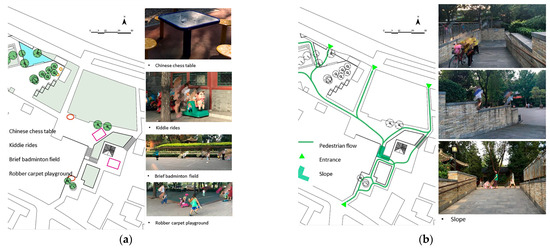
Figure 1.
Features of Shichahai children’s park, (a) masterplan of Shichahai children’s park; (b) entrance and pedestrian flow in Shichahai children’s park.
2.5. Ethical Considerations
This research employs observation as the primary method of data collection, excluding the participation of both children and adults. Prior to commencing data collection, the entire field research procedure underwent review and received approval from the Ethics Committee of the University of Sheffield. The researcher underwent training before formally collecting data to mitigate her influence on the activities of both children and adults. Informed consent was obtained from all subjects involved in the study. Additionally, the local government also granted approval for the data collection to occur within the park.
3. Results
3.1. General Situations
Based on the findings from our field research, it becomes evident that, for children residing in the central area of Beijing, their outdoor play and travel experiences are typically accompanied by adult caregivers. The data collected during our extensive observations at Shichahai children’s park, spanning six days, with two hours of observation each day, revealed compelling insights. Throughout this period, we recorded a total of 404 children (comprising 244 boys and 160 girls) actively engaging in outdoor play and exploration within the park. Concurrently, we also documented the presence of 334 accompanying adults, further classified as 219 parents and 115 grandparents, who were actively involved in supervising and caring for the children during their outdoor activities.
Our analysis of the data, as presented in Figure 2, underscores some noteworthy patterns. Firstly, it is evident that there is a higher representation of parents (219) in the role of supervising children’s outdoor play activities compared to grandparents (115). This finding could be indicative of the immediate and direct involvement of parents in their children’s daily routines and recreational pursuits. Furthermore, when examining the gender breakdown within the parent and grandparent generations, another interesting trend emerges. Among parents, a greater number of females (173) are actively engaged in caring for and supervising children’s outdoor activities, while a smaller proportion comprises males (46). Within the grandparent generation, a similar pattern emerges, with a higher number of females (59) participating in caregiving roles compared to their male counterparts (56).
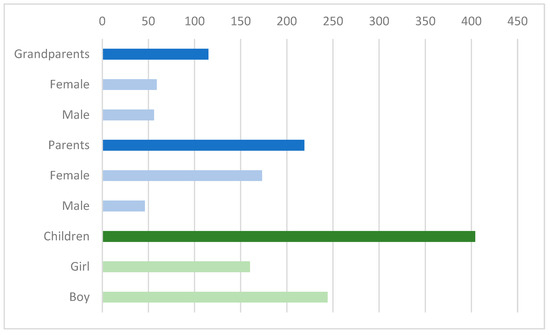
Figure 2.
Demographic of recorded children and caregivers.
3.2. Spatial Distribution of Children in the Whole Park Area
According to the spatial-activity data collected through behavior mapping, in this park, there are several spaces which are especially liked by children (Figure 3). Among these popular spaces, the most favored play spaces are the two rubber carpet playgrounds and the square next to the large rubber carpet playground. The rubber carpet playground provides children with flat ground and a wide space to chase and run, while the square under the trees provides more occluded spaces to conduct stationary play. At the eastern corner of the square, there are several kiddie rides, which are popular with younger children. As well as these extremely popular play spaces, the Chinese chess table is also attractive for some older children. The slope bridging the level difference between the two parts of the whole park is also a good place to play with bicycles, scooters, and roller skates.
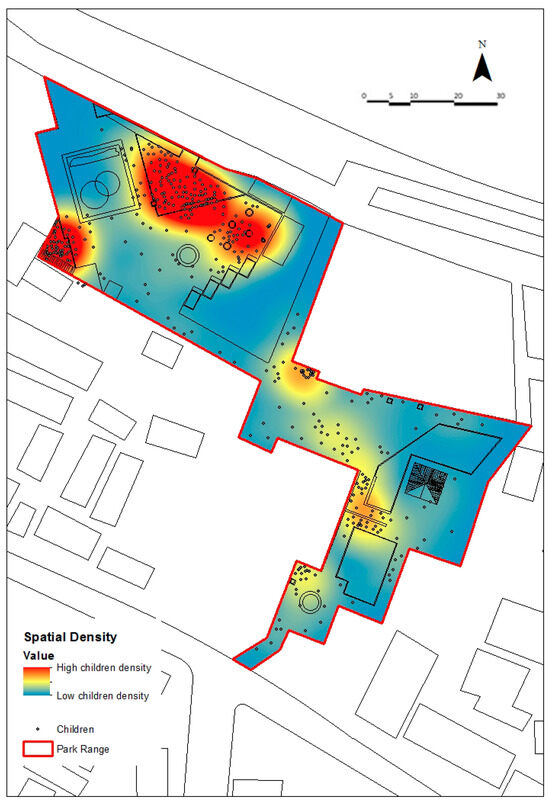
Figure 3.
Spatial distribution of children.
3.3. Spatial Distribution of Different Levels of Children’s Physical Activities
To further understand the relationship between the spatial arrangements and children’s use of the spaces, the different levels of children’s physical involvement and the spatial preferences of these different activities are analyzed, as seen Figure 4a–f. From the lowest level of physical involvement to the highest, Figure 4a–f shows the spatial preferences for these different play activities. The stationary games (b), which include chatting, sitting, playing chess, watching others playing, usually take place at three places: the Chinese chess tables, benches, and kiddie rides. In these places, chairs, benches, and tables are provided for children to sit and play. Stationary play with small-scale physical movements frequently takes place on the rubber carpet playgrounds (c). The children usually stay together, playing with a toy or watching others playing with toys. The main activities involving slow to moderate level translocation, like slow running and chasing, also take place on the carpet playground and the square, as well as on the pavements around these playgrounds (d) and (e). Strenuous physical activities like cycling, roller skating, or playing ball games frequently happen on the slope which connects the two parts of the park (f). The connecting long slope provides children with a certain level of challenge to play with bicycles, scooters, and roller skates, increasing the play value and experience of the equipment. Less structured play, such as passing-through or hanging around to find play partners or opportunities, takes place at the small badminton field or on the slope where there is an open view to observe what is going on within the whole park (a).
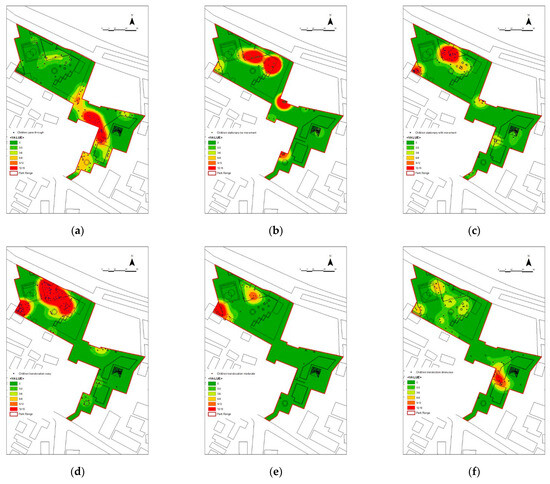
Figure 4.
(a) Children passing by; (b) stationary—no movement; (c) stationary—with movement; (d) translocation—slow; (e) translocation—medium; (f) translocation—fast.
3.4. Spatial Distribution of Different Ages
Figure 5 presents a comprehensive breakdown of the age distribution of children observed in Shichahai Children’s Park. The predominant group comprises children under the age of six, who are often found engaging in various activities around the park. These young children tend to gravitate towards the flat rubber carpet playgrounds, the square adjacent to the large carpet playground, and the pathways leading to the park’s slopes (see Figure 5a–d). These areas provide a safe and engaging environment for their age group. Conversely, as depicted in Figure 5a–c, children over six years old exhibit less interest in the park’s fixed play facilities, such as kiddie rides. Instead, they are more inclined to interact with other children, engaging in activities like chasing or running throughout the entire park. This age group seeks a more dynamic and unstructured play experience that encourages social interaction and physical activity. Moving into the older age bracket of 9 to 11 years in Figure 5d, a notable trend emerges: playing chess becomes their predominant activity within the park. These older children appreciate the park as a place where they can engage in strategic and intellectual games, fostering cognitive development and social engagement.
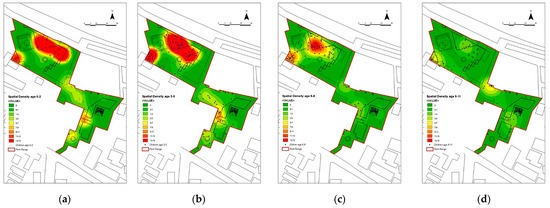
Figure 5.
Spatial distribution of children in different age groups. (a) Children aged 0–2; (b) children aged 3–5; (c) children aged 6–8; (d) children aged 9–11.
3.5. Spatial Distribution of Caregivers—Parents
As previously mentioned, the majority of adults responsible for supervising children’s outdoor play in Shichahai Children’s Park are parents. Moreover, a closer examination of the data reveals an interesting gender-based distribution among these parental caregivers, with a notable presence of mothers compared to fathers (as illustrated in Figure 6). This observation aligns with broader societal trends where mothers often take on a significant role in childcare responsibilities.
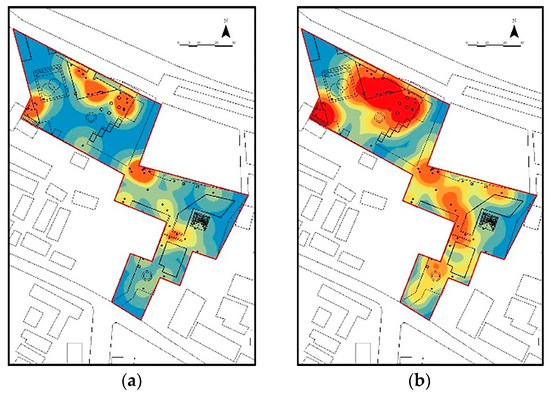
Figure 6.
Spatial distribution of parents. (a) Areas supervised by paternal caregivers; (b) areas supervised by maternal caregivers.
Delving deeper into the spatial analysis of the distribution of maternal and paternal caregivers within the park, it becomes evident that the caregiving responsibilities are predominantly assumed by maternal figures. Figure 6a,b provides visual representations of this trend, indicating that a substantial portion of the park space falls under the intermittent supervision of maternal caregivers.
3.6. Spatial Distribution of Caregivers—Grandparents
According to the behavior mapping data, grandparents also take responsibility for taking care of children playing in public open spaces. Grandmothers and grandfathers who take care of their grandchildren in the park outnumber fathers, while the number of grandmothers or grandfathers supervising children’s outdoor play are around the same.
According to the density analysis of accompanying grandparents, the covering ranges of grandmothers and grandfathers (Figure 7a,b) are almost the same, but the big difference between grandmothers’ supervision and grandfathers’ supervision is that more grandfathers prefer to take their grandchildren to play on the kiddie rides. Grandfathers are the group who are observed taking children to play on the kiddie rides most frequently, but grandmothers rarely do this.
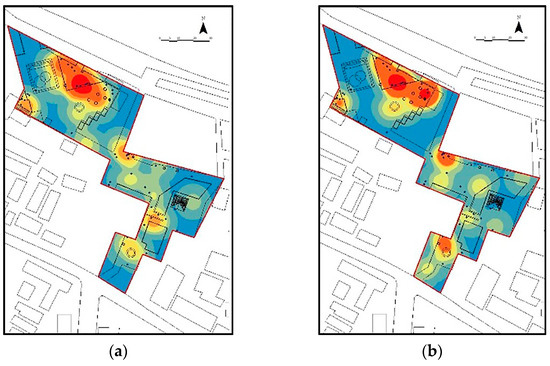
Figure 7.
Spatial distribution of grandparents. (a) Areas supervised by grandmothers; (b) areas supervised by grandfathers.
4. Discussion
Observations and behavior mapping were used to document the actions of both children and caregivers in the park. The findings shed light on a critical facet of sustainability, particularly in the context of densely populated Chinese cities: the efficient utilization of urban public space. These observations and mappings revealed that each type of play activity required specific spatial arrangements. At times, the suitability of a location determined whether a particular play activity could occur there. However, it was evident that within the children’s park, the full potential of each space’s affordances had not been fully realized. This untapped potential could offer diverse play opportunities for children of different ages. This untapped potential within the park represents a missed opportunity for sustainability.
Generally, in the children’s park, the primary venues for various children’s play activities were the flat and soft rubber carpet playgrounds without facilities. Most stationary and slow-moving play occurred in these areas. Similarly, fixed-play facilities such as kiddie rides and Chinese chess tables primarily supported sanitary play behaviors. Reflecting on previous research conducted in the US [23,24] and Northern Europe [13,15] this result indicated that the carpet playground, resembling a pavement, and most of the fixed play facilities were associated with low levels of physical activity. Furthermore, the results demonstrated that the slope connecting the two parts of the park sustained a wider variety of strenuous physical activities. However, these spaces were not originally designed for children, as they were often considered informal play spaces in previous research [25].
The research also revealed a strong connection between the use of spaces in the park and children’s ages. Among younger children, the flat carpet playgrounds and fixed play facilities were the most sought-after spots. In contrast, older children, who preferred more demanding physical activities, found the flat carpet playground inadequate. According to the theory of affordance [10], young children were drawn to formal play spaces like the rubber carpet playground and fixed play facilities due to their bright colors and inviting features. Older children, on the other hand, were more adept at recognizing the potential of spaces and using them in unique ways. Therefore, this research supported the theory of affordance by emphasizing that the perception and utilization of space potential were strongly linked to children’s age [26].
Furthermore, the higher presence of maternal adults supervising children’s outdoor play indicated a significant maternal influence on children’s experiences. This maternal dominance in supervision, reported in the USA [27,28], Canada [29], and Europe [30], was primarily attributed to the cultural role of mothers, which was further reinforced in traditional Chinese culture. Additionally, parenting styles had an impact on children’s play behavior, particularly in terms of risk-taking attitudes, as demonstrated in previous research in the USA [31]. However, the specific mechanisms of maternal-dominated supervision of children’s outdoor play activities were not explored in-depth in this research, leaving room for future investigation.
Insights gleaned from field research indicate that co-parenting by grandparents is a common occurrence, particularly during children’s outdoor play [32,33,34]. The involvement of grandmothers and grandfathers does not differ significantly in terms of quantity. However, a substantial difference exists between the supervision styles of grandmothers and grandfathers. Grandfathers show a clear preference for paid facilities. This phenomenon, newly reported here, might stem from varying concepts of child-rearing and household expenditure between grandfathers and grandmothers. These differing perspectives could impact their attitudes towards allowing children to engage with paid facilities. Nevertheless, this connection remains unverified by this study, necessitating further exploration.
While this study has shed light on various aspects of play activities and caregiver influences within a children’s park, several limitations should be acknowledged. Firstly, the research primarily focused on a single children’s park, which may not fully represent the diversity of play environments in other locations. Additionally, the exploration of the specific mechanisms behind maternal-dominated supervision and the preferences of grandmothers and grandfathers for paid facilities remains somewhat superficial, warranting further in-depth investigation.
In light of these limitations, several recommendations for future research and practical considerations emerge. Future studies should consider employing a longitudinal approach to capture the evolving dynamics of play activities and caregiver influences in children’s parks. Moreover, expanding the scope of research to include multiple parks across different cultural contexts could provide a more comprehensive understanding of these phenomena. Additionally, qualitative research methods, such as interviews and focus groups, may offer valuable insights into the intricacies of maternal and grandparental roles in shaping children’s outdoor play experiences. Finally, park designers and policymakers should take into account the varying needs and preferences of children of different ages when planning and designing play spaces, ensuring that they maximize the full potential of each area to provide diverse and stimulating play opportunities for children, especially in high-density urban areas.
5. Conclusions
In conclusion, this study has employed observations and behavior mapping to provide valuable insights into the dynamics of play activities and caregiver influences within a children’s park. It has become evident that the design and arrangement of play spaces played a pivotal role in shaping the types of activities that occur within them. This highlights the necessity for thoughtful spatial planning to maximize play opportunities, ultimately contributing to the development of a sustainable city by improving the efficiency of limited outdoor spaces.
The study has illuminated the prominence of flat carpet playgrounds and fixed play facilities as central venues for children’s play, underscoring their potential as sustainable urban assets that promote physical activity and social interaction. Furthermore, the age-related preferences for specific play areas offer guidance for creating inclusive environments that cater to the diverse needs of children of varying ages, contributing to the overall health and well-being of urban communities.
Maternal involvement in outdoor play activities, influenced by cultural roles and parenting styles, presents an opportunity for sustainability through the promotion of outdoor and recreational spaces as well as family bonding in urban areas. Additionally, the involvement of grandparents in co-parenting revealed interesting variations in preferences, suggesting a potential link between child-rearing concepts and spending patterns.
In essence, these findings underscore the multifaceted relationship between urban planning, caregiver dynamics, and the development of inclusive and stimulating play environments for children of all ages. They emphasize the need for a holistic approach to sustainability that integrates spatial design, community engagement, and cultural understanding in shaping vibrant and resilient urban spaces. Further research in this field is essential to delve deeper into these patterns and unlock their full potential for sustainable urban development.
Author Contributions
Conceptualization, P.T. and H.W.; methodology, P.T.; software, P.T.; validation, P.T.; formal analysis, P.T.; investigation, P.T.; resources, P.T.; data curation, P.T.; writing—original draft preparation, P.T.; writing—review and editing, P.T. and H.W.; visualization, P.T.; supervision, H.W. All authors have read and agreed to the published version of the manuscript.
Funding
This research was funded by the Ministry of Science and Technology, High-end Foreign Experts Introduction Plan, grant number G2022133023L; and sponsored by Shanghai Pujiang Program, grant number 22PJC109.
Institutional Review Board Statement
The study was conducted in accordance with the Declaration of Helsinki, and approved by the Ethics Committee of the University of Sheffield. Protocol code: 2017-086-187 and date of approval: 6 August 2017.
Informed Consent Statement
Informed consent was obtained from all subjects involved in the study.
Data Availability Statement
The data that support the findings of this study are available from the first author, Pai Tang, upon reasonable request.
Conflicts of Interest
The authors declare no conflict of interest.
References
- Reimers, A.K.; Knapp, G. Playground usage and physical activity levels of children based on playground spatial features. J. Public Health 2017, 25, 661–669. [Google Scholar] [CrossRef]
- Opie, I.; Opie, P. Children’s Game in Street and Playground; Oxford University Press: Oxford, UK, 1969. [Google Scholar]
- Hoseeini, A.; Salehinia, M.; Shafaei, M.; Sedghpour, S. Playful Environment: The Literature Review on Environmental Affordances to Motivate Kids to Play (EAMKP). Int. J. Archit. Eng. Urban Plan. 2021, 31, 2021. [Google Scholar] [CrossRef]
- Shackell, A.; Butler, N.; Doyle, P.; Ball, D. Design for Play: A Guide to Creating Successful Play Spaces; Department for Culture, Media and Sport Department for Children, Schools and Families: London, UK, 2008; p. 156. Available online: http://eprints.mdx.ac.uk/5028/ (accessed on 17 July 2023).
- Woolley, H.; Lowe, A. Exploring the Relationship between Design Approach and Play Value of Outdoor Play Spaces. Landsc. Res. 2013, 38, 53–74. [Google Scholar] [CrossRef]
- Kyttä, M. Children in Outdoor Contexts: Affordances and Independent Mobility in the Assessment of Environmental Child Friendliness; Helsinki University of Technology: Espoo, Finland, 2003. [Google Scholar]
- Heft, H. Affordances of children’s environments: A functional approach to environmental description. Child. Environ. Q. 1988, 5, 29–37. [Google Scholar]
- Gibson, J. The Ecological Approach to Visual Perception; Lawrence Erlbaum Associates: Hillsdale, NJ, USA, 1986. [Google Scholar]
- Yatiman, N.A.; Aziz, N.F.; Said, I. Affordances of Homeschool Journey in Rural Environment for Children’s Performances. Procedia Soc. Behav. Sci. 2012, 68, 395–405. [Google Scholar] [CrossRef][Green Version]
- Kyttä, M.; Oliver, M.; Ikeda, E.; Ahmadi, E.; Omiya, I.; Laatikainen, T. Children as urbanites: Mapping the affordances and behavior settings of urban environments for Finnish and Japanese children. Child Geogr. 2018, 16, 319–332. [Google Scholar] [CrossRef]
- Laaksoharju, T.; Rappe, E.; Kaivola, T. Garden affordances for social learning, play, and for building nature-child relationship. Urban For. Urban Green. 2012, 11, 195–203. [Google Scholar] [CrossRef]
- Brown, S.L.; Gravil, M.; Jacobi-Vessels, J. Planning and Building Children’s Outdoor Play Zones for Multiple Affordances: A Community-Engaged Process. Int. J. Early Child. Environ. Educ. 2022, 10, 3–13. Available online: https://bernheim.org/ (accessed on 17 July 2023).
- Sando, O.J.; Sandseter, E.B.H. Affordances for physical activity and well-being in the ECEC outdoor environment. J. Environ. Psychol. 2020, 69, 101430. [Google Scholar] [CrossRef]
- Lerstrup, I.; Møller, M.S. Affordances of Ditches for Preschool Children. Child Youth Environ. 2016, 26, 43. [Google Scholar] [CrossRef]
- Rutkauskaite, R.; Gisladottir, T.; Pihu, M.; Kjonniksen, L.; Lounassalo, I.; Huovinen, T.; Gruodyte-Raciene, R.; Visagurskiene, K.; Olafson, O.; Kull, M.; et al. Schoolyard affordances for physical activity: A pilot study in 6 nordic–baltic countries. Sustainability 2021, 13, 11640. [Google Scholar] [CrossRef]
- Kjønniksen, L.; Wiium, N.; Fjørtoft, I. Affordances of School Ground Environments for Physical Activity: A Case Study on 10- and 12-Year-Old Children in a Norwegian Primary School. Front. Public Health 2022, 10, 773323. [Google Scholar] [CrossRef] [PubMed]
- Farmer-Dougan, V.; Kaszuba, T. Reliability and validity of play-based observations: Relationship. Educ. Psychol. 1999, 19, 429–440. [Google Scholar] [CrossRef]
- Phelan, S. Case study Research: Design and Methods, 5th ed.; Sage: Newcastle upon Tyne, UK, 2014; Volume 5. [Google Scholar] [CrossRef]
- Robson, C. Real World Research, 2nd ed.; Blackwell Publishers: Oxford, UK, 2002. [Google Scholar]
- Durant, R.H.; Baranowski, T.; Puhl, J.; Rhodes, T.; Davis, H.; Greaves, K.A.; Thompson, W.O. Evaluation of the Children’s Activity Rating Scale (CARS) in young children. Off. J. Am. Coll. Sports Med. 1993, 25, 1415–1421. [Google Scholar] [CrossRef]
- van Dijk-Wesselius, J.E.; Maas, J.; van Vugt, M.; van den Berg, A.E. A comparison of children’s play and non-play behavior before and after schoolyard greening monitored by video observations. J. Environ. Psychol. 2022, 80, 101760. [Google Scholar] [CrossRef]
- Cosco, N.G.; Moore, R.C.; Islam, M.Z. Behavior mapping: A method for linking preschool physical activity and outdoor design. Med. Sci. Sports Exerc. 2010, 42, 513–519. [Google Scholar] [CrossRef]
- Cohen, D.A.; Han, B.; Williamson, S.; Nagel, C.; McKenzie, T.L.; Evenson, K.R.; Harnik, P. Playground features and physical activity in U.S. neighborhood parks. Prev. Med. 2020, 131, 105945. [Google Scholar] [CrossRef]
- Cohen, D.A.; Talarowski, M.; Han, B.; Williamson, S.; Galfond, E.; Young, D.R.; Eng, S.; McKenzie, T.L. Playground Design: Contribution to Duration of Stay and Implications for Physical Activity. Int. J. Environ. Res. Public Health 2023, 20, 4661. [Google Scholar] [CrossRef]
- Law, S.; Seresinhe, C.I.; Shen, Y.; Gutierrez-Roig, M. Street-Frontage-Net: Urban image classification using deep convolutional neural networks. Int. J. Geogr. Inf. Sci. 2020, 34, 681–707. [Google Scholar] [CrossRef]
- Nasri, M.; Tsou, Y.T.; Koutamanis, A.; Baratchi, M.; Giest, S.; Reidsma, D.; Rieffe, C. A Novel Data-driven Approach to Examine Children’s Movements and Social Behaviour in Schoolyard Environments. Children 2022, 9, 1177. [Google Scholar] [CrossRef]
- Walls, J.K.; Helms, H.M.; Grzywacz, J.G. Intensive Mothering Beliefs Among Full-Time Employed Mothers of Infants. J. Fam. Issues 2016, 37, 245–269. [Google Scholar] [CrossRef]
- Moon-Seo, S.K.; Munsell, S.E.; Kim, N. Mothers’ and Fathers’ Perceptions of Children’s Play. Early Child. Educ. J. 2023, 1–13. [Google Scholar] [CrossRef]
- Clark, E.; Dumas, A. Children’s active outdoor play: ‘Good’ mothering and the organisation of children’s free time. Sociol. Health Illn. 2020, 42, 1229–1242. [Google Scholar] [CrossRef]
- Yurt, Ö.; Keleş, S. How about a risky play? Investigation of risk levels desired by children and perceived mother monitoring. Early Child. Dev. Care 2021, 191, 749–759. [Google Scholar] [CrossRef]
- Hagan, L.K.; Kuebli, J. Mothers’ and fathers’ socialization of preschoolers’ physical risk taking. J. Appl. Dev. Psychol. 2007, 28, 2–14. [Google Scholar] [CrossRef]
- Goh, E.C.L.; Kuczynski, L. ‘Only children’ and their coalition of parents: Considering grandparents and parents as joint caregivers in urban Xiamen, China. Asian J. Soc. Psychol. 2010, 13, 221–231. [Google Scholar] [CrossRef]
- Sun, Y.; Jiang, N. The Effect of Grandparents’ Co-parenting on Young Children’s Personality and Adaptation: Chinese Three-generation-families. Asian Soc. Sci. 2017, 13, 7. [Google Scholar] [CrossRef]
- Tang, P. Growing up in Beijing: Children’s Outdoor Play and Related Experiences across Three Generations. Ph.D. Thesis, The University of Sheffield, Sheffield, UK, 2020. [Google Scholar]
Disclaimer/Publisher’s Note: The statements, opinions and data contained in all publications are solely those of the individual author(s) and contributor(s) and not of MDPI and/or the editor(s). MDPI and/or the editor(s) disclaim responsibility for any injury to people or property resulting from any ideas, methods, instructions or products referred to in the content. |
© 2023 by the authors. Licensee MDPI, Basel, Switzerland. This article is an open access article distributed under the terms and conditions of the Creative Commons Attribution (CC BY) license (https://creativecommons.org/licenses/by/4.0/).